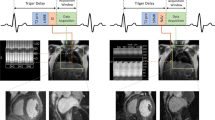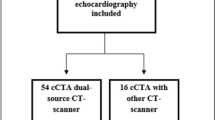Abstract
Diameters of coronary artery aneurysms (CAAs) complicating acute phase KD can strongly predict the long-term prognosis of coronary artery lesions (CAL). Recently, computed tomographic angiography (CTA) has been used to detect CAL, and the purpose of this study was to determine whether coronary artery diameters measurements by CTA using dual-source computed tomography (DSCT) can be used instead of coronary angiogram (CAG) measurements. Twenty-five patients (22 males and three females) with CAL due to KD, who had undergone both CTA and CAG within one year, were retrospectively evaluated between 2007 and 2013. A prospective electrocardiogram-triggered CTA was performed on a DSCT (SOMATOM® Definition, Siemens Healthcare, Germany). Two pediatric cardiologists independently measured the diameters of CAAs twice in each maximum intensity projection (MIP), curved multiplaner reconstruction (MPR) and CAG. We measured 161 segments in total (segment 1–3, 5–7, 11, 13). Diagnostic accuracy was expressed as κ coefficient. A Bland–Altman analysis was also used to assess the intra-observer, inter-observer and inter-modality agreement. The diagnostic quality of CTA was excellent (κ = 0.93). Excellent inter-observer agreement for the diameters of CAAs was obtained for MIP, MPR and CAG and for the intra-observer agreement. The inter-modality agreement was also excellent in measurements of CAA (MPR–CAG: y = 0.9x + 0.40, r = 0.97, p < 0.0001 MIP–CAG: y = x + 0.1, r = 0.94, p < 0.0001). These values in normal coronary arteries were also obtained. We found a significant correlation between CTA and CAG in measuring the coronary arteries. We conclude that measuring coronary artery diameters by CTA is reliable and useful.





Similar content being viewed by others
References
Chao BT, Wang XM, Wu LB et al (2010) Diagnostic value of dual-source CT in Kawasaki disease. Chin Med J (Engl) 123:670–674
Duan Y, Wang X, Cheng Z et al (2012) Application of prospective ECG-triggered dual-source CT coronary angiography for infants and children with coronary artery aneurysms due to Kawasaki disease. Br J Radiol 85:e1190–e1197
Glatz AC, Patel A, Zhu X et al (2014) Patient radiation exposure in a modern, large-volume, pediatric cardiac catheterization laboratory. Pediatr Cardiol 35:870–878
Itou T (2010) Research & collaboration: the optimization of CT scanning protocol for pediatrics. Siemens Future 19:50–51
Kaichi S, Tsuda E, Fujita H et al (2008) Acute coronary artery dilation due to Kawasaki disease and subsequent late calcification as detected by electron beam computed tomography. Pediatr Cardiol 29:568–573
Matsuo O, Tsuda E, Kanzaki S et al (2010) Evaluation of coronary artery lesions by dual-source computed tomography in patients under 12 years old after Kawasaki disease. Prog Med 30:1891–1894 (in Japanese)
Mavrogeni S, Papadopoulos G, Douskou M et al (2004) Magnetic resonance angiography is equivalent to X-ray coronary angiography for the evaluation of coronary arteries in Kawasaki disease. J Am Coll Cardiol 43:649–652
Sabarudin A, Sun Z, Yusof AK (2013) Coronary CT angiography with single-source and dual-source CT: comparison of image quality and radiation dose between prospective ECG-triggered and retrospective ECG-gated protocols. Int J Cardiol 168:746–753
Suzuki A, Kamiya T, Ono Y et al (1987) Follow-up study of coronary artery lesions due to Kawasaki disease by serial selective coronary arteriography in 200 patients. Heart Vessels 3:159–165
Tsuda E, Kamiya T, Ono Y et al (2005) Incidence of stenotic lesions predicted by acute phase changes in coronary arterial diameter during Kawasaki disease. Pediatr Cardiol 26:73–79
Tsujii N, Tsuda E, Kanzaki S et al (2014) Late wall thickening and calcification in patients after Kawasaki disease noninvasively detected by dual source computed tomography. Circulation 130:A17654 (abstract)
Xu Y, Tang L, Zhu X et al (2010) Comparison of dual-source CT coronary angiography and conventional coronary angiography for detecting coronary artery disease. Int J Cardiovasc Imaging 26(Suppl. 1):75–81
Xu H, Zhu Y, Zhu X et al (2012) Anomalous coronary arteries: depiction at dual-source computed tomographic coronary angiography. J Thorac Cardiovasc Surg 143:1286–1291
Acknowledgments
We thank Professor Peter Olley and Dr. Setsuko Olley for their kind English language consultation.
Conflict of interest
The authors state that they have no conflict of interest.
Author information
Authors and Affiliations
Corresponding author
Rights and permissions
About this article
Cite this article
Tsujii, N., Tsuda, E., Kanzaki, S. et al. Measurements of Coronary Artery Aneurysms Due to Kawasaki Disease by Dual-Source Computed Tomography (DSCT). Pediatr Cardiol 37, 442–447 (2016). https://doi.org/10.1007/s00246-015-1297-z
Received:
Accepted:
Published:
Issue Date:
DOI: https://doi.org/10.1007/s00246-015-1297-z




